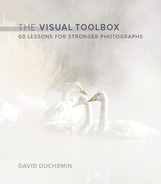Lesson 25. Learn to Sketch
No artist just gets it right the first time. The process of expressing the intent of our imaginations (unlimited as they are by the constraints of the real world) with any craft, let alone one so necessarily limited by technology as photography, is not an easy one. The idea that this craft is easy gets unfairly promoted from all kinds of corners, not the least of which are the camera companies themselves. But it’s not easy. No new camera will help you “shoot like a pro” even if that were a goal worth aspiring to. And because this craft doesn’t come instantly, it’s probably a good idea to pay more attention to our own creative process and stop expecting instant gold from ourselves.
Nikon D3s, 26mm, 1/50 @ f/18, ISO 100
My final photograph, Arctic Circles, after working the scene and creating sketch images over about 12 hours. The next day the circles were gone.
Because we so often see only the final work of the photographers we respect, I think we miss what would be an otherwise eye-opening chance to see that all of them have a process of their own—most of them, if their contact sheets are to be believed, have some kind of sketching process.
I call it sketching because it’s the closest thing to a visual rough draft that I can think of. Painters sketch out their images, and even have a process in painting that often involves scraping the canvas clean and starting again. Writers do the same. I suspect most creative people do, and it’s because the very act of creating something allows our initial vision or idea to get worked out by contact with real-world forces, and that brings about new ideas, new directions, and stronger ways of executing those ideas. But you have to be open to the process of not getting it right the first time. You have to be open to playing, to experimenting, and not holding the final work too tightly. Which is one of the reasons I can’t get on board with this idea of pre-visualizing an image, at least not the way I understand people to generally mean it. I have no idea what the final image is going to look like. I usually know what it’s going to feel like, and that’s much more helpful to me. But if I know what it’s going to look like, I am going to be much less open to change or evolution.
So I don’t look at my failed images as failures. I look at them as a necessary part of the process of getting to the images that do work. They are my rough drafts, and I make hundreds of them. I shoot variations and explore possibilities and I ask myself, “What if I...?” Sometimes those sketch images result in a final photograph several minutes or several hours later. Sometimes it’s several days or months. Years even. I keep most of them, looking through old hard drives like old sketchbooks or notebooks of ideas, which I also keep and look through. And they lead me to new places. They remind me not to get discouraged, because doing so only kills me creatively. And getting discouraged only encourages me to give up, stopping me from making those few more sketch images that might lead to the moment that things click and get me to the heart of what I’m trying to create.
Here are my thoughts on making sketch images:
• Make many of them. If you’re shooting digitally, they cost nothing.
• Make them intentionally, as visual responses to variations on the question, “Hey, what if I did this or that?”
• Study them and react. Don’t just hope 100 sketches will get you somewhere new. Look at them. What’s working? What’s not working? How could you keep what’s working and run in a completely different direction?
“You have to be open to playing, to experimenting, and not holding the final work too tightly.”
• Creativity is the connection of previously unconnected ideas, and the more divergent the better. So take the thing you love about earlier sketches and see if you can combine it with the thing you love about the latest one. Sure, it might result in something equally unworkable, but that one unworkable idea might lead to the very one you needed to realize the final image. Only the process will get you there.
• Be open to having a completely different way of doing this than the way I do it. I don’t see crappy photographs, only sketch images that haven’t gotten me where I’m going yet, but without which I’ll never get there. Find your own process. Allow it to be messy. No one will see these if you don’t want them to. All they will see is the final work.

